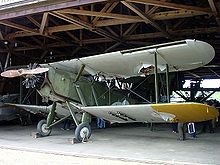
The Fairey Swordfish was a biplane torpedo bomber, designed by the Fairey Aviation Company. Originating in the early 1930s, the Swordfish, nicknamed "Stringbag", was principally operated by the Fleet Air Arm of the Royal Navy. It was also used by the Royal Air Force (RAF), as well as several overseas operators, including the Royal Canadian Air Force (RCAF) and the Royal Netherlands Navy. It was initially operated primarily as a fleet attack aircraft. During its later years, the Swordfish was increasingly used as an anti-submarine and training platform. The type was in frontline service throughout the Second World War.

The Blackburn Roc was a naval fighter aircraft designed and produced by the British aviation company Blackburn Aircraft. It took its name from the mythical bird of the tales of the Arabian Nights, the Roc. It was operated by the Fleet Air Arm (FAA) and was active during the Second World War.

The Fairey Albacore is a single-engine biplane torpedo bomber designed and produced by the British aircraft manufacturer Fairey Aviation. It was primarily operated by the Royal Navy Fleet Air Arm (FAA) during the Second World War.

The Blackburn B-24 Skua was a carrier-based low-wing, two-seater, single-radial engine aircraft by the British aviation company Blackburn Aircraft. It was the first Royal Navy carrier-borne all-metal cantilever monoplane aircraft, as well as the first dive bomber in Fleet Air Arm (FAA) service. The aircraft took its name from the sea bird which 'divebombs' any potential predators that come too close to its nest.

The Blackburn Shark was a carrier-borne torpedo bomber designed and built by the British aviation manufacturer Blackburn Aircraft. It was originally known as the Blackburn T.S.R., standing for "torpedo-spotter-reconnaissance", in reference to its intended roles. The Shark was the last of Blackburn's biplane torpedo bombers.

The Blackburn B-5 Baffin biplane torpedo bomber designed and produced by the British aircraft manufacturer Blackburn Aircraft. It was a development of the Ripon, the chief change being that a 545 hp (406 kW) Bristol Pegasus I.MS radial engine had replaced the Ripon's Napier Lion water-cooled inline engine.

The Blackburn Firebrand was a British single-engine strike fighter for the Fleet Air Arm of the Royal Navy designed during World War II by Blackburn Aircraft. Originally intended to serve as a pure fighter, its unimpressive performance and the priority allocation by the Ministry of Aircraft Production of Napier Sabre engines to the Hawker Typhoon caused it to be redesigned with an alternate engine as a strike fighter to take advantage of its load-carrying capability. Development was slow and the first production aircraft was not delivered until after the end of the war. Only a few hundred were built before it was withdrawn from front-line service in 1953.

The Avro 555 Bison was a British single-engined fleet spotter/reconnaissance aircraft built by Avro.

The Blackburn R-1 Blackburn was a 1920s British single-engine fleet spotter/reconnaissance aircraft built by Blackburn Aircraft.

The Blackburn B.26 Botha was a four-seat reconnaissance and torpedo bomber. It was produced by the British aviation company Blackburn Aircraft at its factories at Brough and Dumbarton.
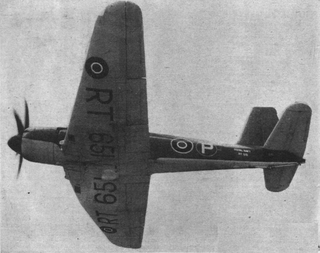
The Blackburn B.48 Firecrest, given the SBAC designation YA.1, was a single-engine naval strike fighter built by Blackburn Aircraft for service with the British Fleet Air Arm during the Second World War. It was a development of the troubled Firebrand, designed to Air Ministry Specification S.28/43, for an improved aircraft more suited to carrier operations. Three prototypes were ordered with the company designation of B-48 and the informal name of "Firecrest", but only two of them actually flew. The development of the aircraft was prolonged by significant design changes and slow deliveries of components, but the determination by the Ministry of Supply in 1946 that the airframe did not meet the requirements for a strike fighter doomed the aircraft. Construction of two of the prototypes was continued to gain flight-test data and the third was allocated to strength testing. The two flying aircraft were sold back to Blackburn in 1950 for disposal and the other aircraft survived until 1952.

The Mitsubishi B2M was a Japanese carrier-based torpedo bomber of the 1920s and 1930s. It was built by Mitsubishi to a design by Blackburn Aircraft of Britain and was operated by the Imperial Japanese Navy.

The Blackburn T.3 Velos was a 1920s British two-seat coastal defence seaplane built by Blackburn Aeroplane & Motor Company Limited, Brough Aerodrome and the Greek National Aircraft Factory.
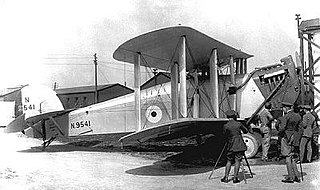
The Blackburn Dart was a carrier-based torpedo bomber biplane aircraft, designed and manufactured by the British aviation company Blackburn Aircraft. It was the standard single-seat torpedo bomber operated by the Fleet Air Arm (FAA) between 1923 and 1933.
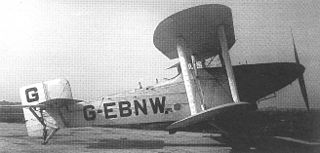
The Avro 571 Buffalo was a prototype British carrier-based torpedo bomber biplane, designed and built by Avro in the 1920s. It was not selected for service, the Blackburn Ripon being ordered instead.
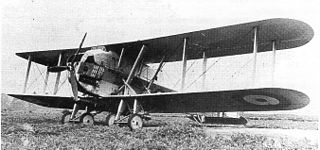
The Blackburn T.4 Cubaroo was a British prototype biplane torpedo bomber of the 1920s. Built by Blackburn Aircraft and intended to carry a large 21 in (533 mm) torpedo, the Cubaroo was claimed to be the largest single-engined aircraft in the world at the time of its first flight.

The Blackburn B-3 was a prototype British torpedo bomber designed and built by Blackburn Aircraft as a potential replacement for the Ripon. It was unsuccessful, with only the two prototypes being built.

The Short Type 320, also known as the Short Admiralty Type 320, was a British two-seat reconnaissance, bombing and torpedo-carrying "folder" seaplane of the First World War.

The Blackburn B.T.1 Beagle was a British single-engine, two-seat biplane bomber/torpedo aircraft from 1928. Designed to Air Ministry specifications which led to no contracts for any manufacturer, only one Beagle was built.

The Handley Page H.P.31 was a two-seat single-engined biplane built to a British specification for a carrier-based torpedo bomber and reconnaissance aircraft. After trials, the Blackburn Ripon was preferred, though the Harrow played a significant role in the development of automatic slots.


